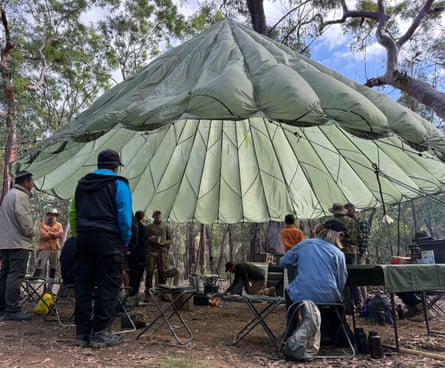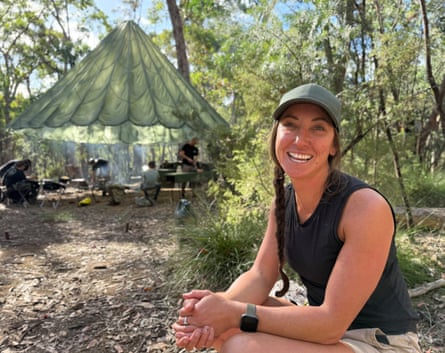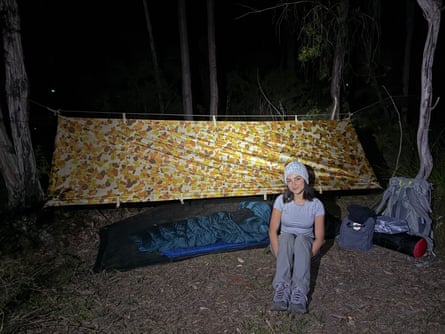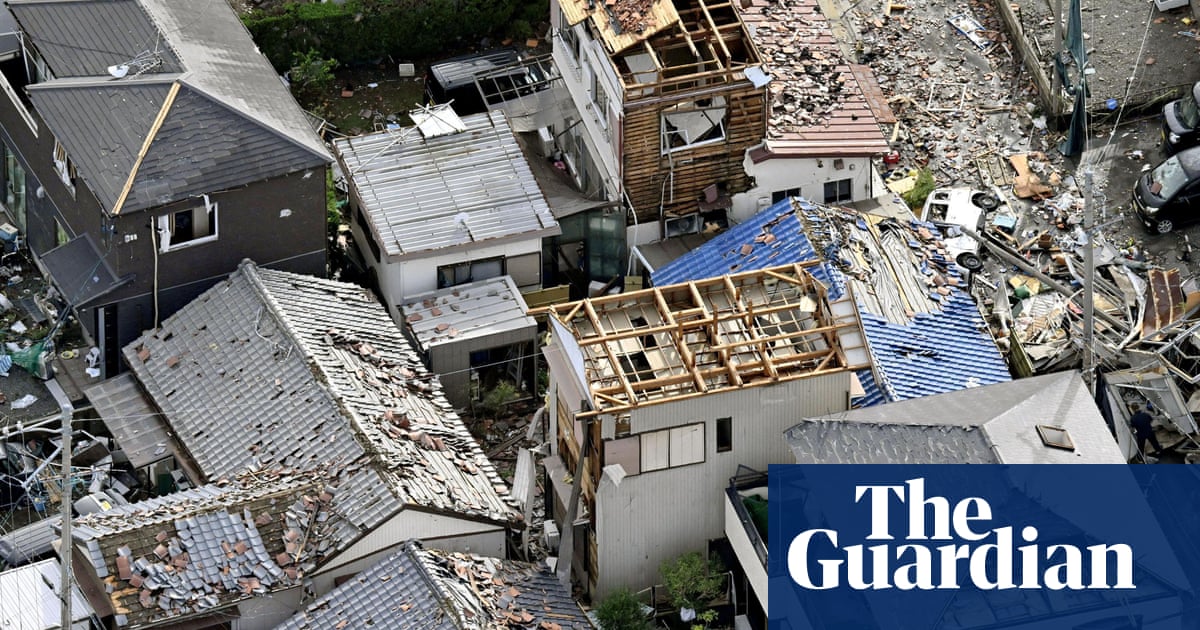On our very first night in the bush, Gordon Dedman issued a warning: “Fussy people die.”
Dedman, a man with an apt name for a military survival instructor, is all muscle and green khaki. Sat by the fire, he addresses his students.
“This is not a wellness retreat. It is about getting out of your comfort zone.”
I am in the Camden bush, on Dharawal and Gundungurra Country, for a four-day wilderness survival course taught by the consultant for TV’s most gruelling show, Alone Australia.
On the itinerary: knife work, knots, emergency shelters, fire lighting, water collection, plant identification, solar and celestial navigation, plus emergency signalling and rescue techniques. On my person: fresh hiking boots, gold hoops, perfectly low-rise cargo pants and a black tee.
The last time I went camping was with school in year 9, in a tent set up about 50 steps from a cabin. Out of my comfort zone, indeed – this time I don’t have a tent, or a toilet.
After a short hike, we arrive at sunset to a large green tarp billowing gently. It’s a military parachute, Dedman tells us. We gather at a semicircle of stools beneath the canopy.

Dedman gets straight to it. The goal of “survival” is to be found, he says. This is different to bushcraft, which has a direct relationship with nature and draws from the skills traditional cultures used to live in the wilderness.
Dedman’s philosophy about the land and people’s role on it is clear just a few hours in: “Our existence here is based on the caring capacity of the Earth.
“But we live in a system of expanding expenditure … at total odds with nature. Something is very broken with our system.”
We go around the circle of 15 students, introducing ourselves. Most of us are novices, mainly Sydney and Canberra-based men with office jobs looking to reconnect with the outdoors (participant Julian Carrick says he is here to “soothe the soul” and “see the stars”) plus two parents, their eager sons and myself.
Some students have dabbled in survival and bushcraft for years – including Karla Pound, a National Geographic expedition leader and contestant on the current season of Alone.

We’re not equipped for when things go wrong, she tells me. She says even during common occurrences such as power outages and floods, “people don’t know the first thing to do”.
“It is really important to have these basic, fundamental skills under your belt.”
The parachute tarp becomes our base for the next four days, with classes held early in the morning and late at night. These hours are by design, to simulate the exhaustion and distraction one might feel in a real survival situation. Meanwhile our days are structured around practical skills.
First, knives (I’m limp-wristed and slow), then knots (I actually catch on). We use both to set up our first emergency shelters – pitched plastic sheets strung up between two trees and secured with pegs we carved ourselves, totally open to the surrounds. These structures are called hootchies.

I am slow to find a spot – too picky, terrified of sleeping near thick shrubbery. It’s a justified fear, I’d say, given we are in the habitat of funnel web spiders, king brown and red belly black snakes.
By the time I choose a location, the sun is setting. I fumble in the dark, trying to hold all my ropes and pegs in place. It is only thanks to kind peers – a physio and a former-detective-turned-teacher – that I am able to set up in time for dinner.
“The western world has a problem with food aversion,” Dedman says at meal time. So true. I’m hungry for the potato cooking under the bonfire coals we are sitting around.
We waste so much, he says, we’re disconnected from our food’s sources. I nod when he mentions more sustainable protein alternatives to beef.
Then he brings out a container of live meal worms. We are going to eat them, he says. I laugh. Classic Dedman!
My head torch lights up the plump, yellow bodies writhing in the container and visceral anxiety floods my stomach. “Fussy people die.” After several failed attempts, I get the worms into my mouth.
They wriggle around my fingers. They thrash against my lips. They burst between my teeth, and the group applauds. I actually enjoy the taste. This will forever be my greatest feat. I am overcome with relief!
But Dedman has leftovers.

I was too hesitant, he tells me. I can will myself to do anything, he says. Eat more.
I manage to eat a second squirming helping and then Dedman lets me be. Our next course: crickets.
after newsletter promotion
We are shown how to take one in our hands, efficiently break off its head, slide the body on to a stick and roast it over the fire.
My throat is closing up at this point. The insects are jumping. My hands are shaking. A course instructor suggests I try breathing.
“It’s twitching in the fire!” the 12-year-old observes. I realise if I’m actually caught out in the bush I’ll likely perish because I can’t catch, behead and eat a cricket. An instructor does it for me.
Ever since being attacked by a swarm of seagulls on a beach, I’ve been a little jumpy around animals. I start overthinking my impending night’s sleep – what if I wake up to a snake in my sleeping bag?
But on a midnight walk to learn celestial navigation before bed, my thoughts are interrupted when we turn off our torches and look up.
The air is crisp, the surrounds are silent and the sky glimmers. Fear is replaced by cool, calm peace. I have a great night’s sleep.

The next day we learn to make fire with our knife and a ferro rod, and purify creek water. While learning about local flora on a bush walk, Dedman throws impromptu challenges at us – five minutes to gather tinder and kindle and start a fire.
All this skill-building has been working us up to the task of our third night – finding an ally or two, scoping out a safe spot and setting up an emergency base. I turn to my new friends Daniel and Damien and we set off, racing against our faux competition who have their sights set on the same campsite.
We string up our reflective blankets at a tilt between two trees, light a fire, filter our creek water and prepare a hearty meal of kangaroo stew.

We eat and chat beneath the night sky and I start to feel a little sad. This place is so beautiful and tomorrow I have to go home.
“I mean, just look around you,” Carrick, a peer on the course, said earlier in the day. “This place is heaven right here. You don’t need to look any further.”
How not to die
Dedman’s lessons differ depending on the environment. Here are a few general takeaways for when you are lost or stranded.
-
Mindset is important. Panic is dangerous and can affect those around you. You need to be able to plan, act and hold the will to live.
-
Make sure you think through your survival priorities. The rule of threes is governed by what will harm you first: you can survive just three minutes without air, three days without water and three weeks without food.
-
Follow the PLAN acronym: protection (first aid, clothing, shelter, fire), location (attracting, holding and directing attention), acquisition (of water, then food) and navigation (orientation, travel, direction).
-
When going anywhere remote, ensure you can be found. Have a satellite communication device like an EPIRB (emergency position-indicating radiobeacon) on you. Also take stock of everything you have that can attract attention in the natural environment – shiny, bright and reflective materials. You can set these up between trees as a method of passive signalling, fly a bright flag at the end of a big stick, or make a ground-to-air sign with letters. “V” is the international emergency distress symbol. A ground to air sign has to be 6m x 3m to be seen by a passing aerial vehicle or satellite.
-
Search efforts are conducted in patterns. Aircraft will do a box search at the height they can see an animal move. A ground search will follow a track, a river, or man-made things such as telecommunication towers and windmills. Contour searches of mountains are conducted by circling. If you know these patterns, you can set your signalling to capitalise on where you will most likely be seen.
Find more in depth advice on the Bushcraft Survival Australia blog.
The details
The three-day fundamentals module 1 course costs $855 for an adult, or $427.50 for a child (aged 12 and up). Bushcraft Survival runs courses around Australia, which can be booked online.
-
The journalist attended as a guest of Bushcraft Survival Australia

 3 months ago
100
3 months ago
100

















































